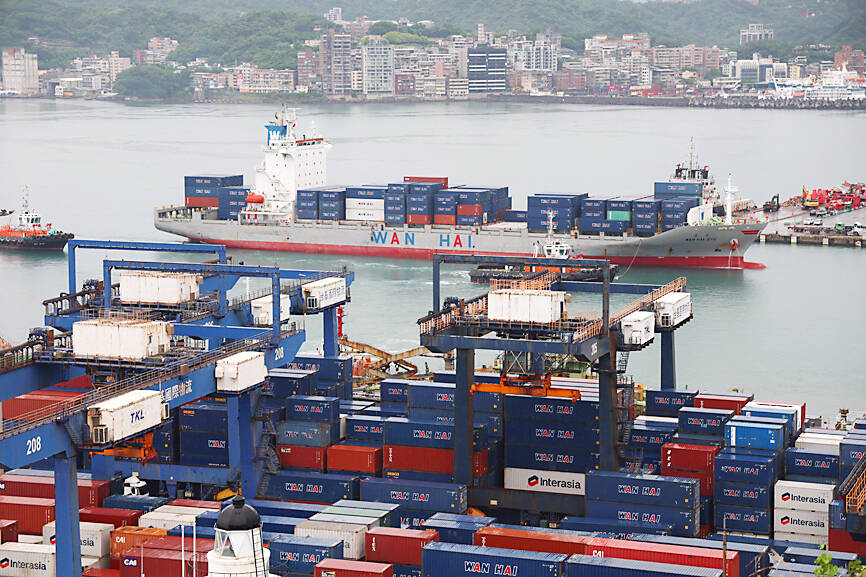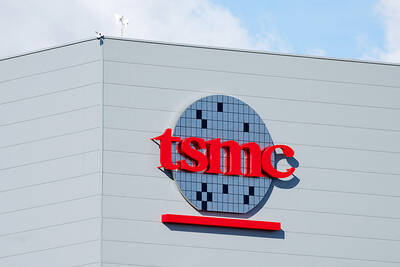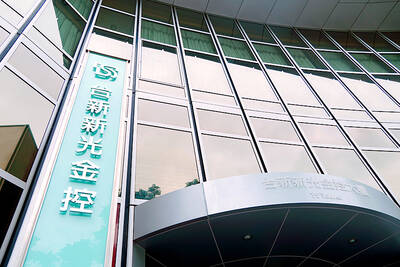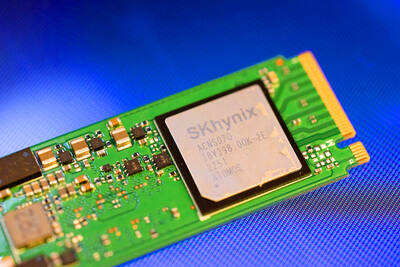Export orders expanded 24.6 percent year-on-year last month to US$56.77 billion, driven by robust demand for artificial intelligence (AI) and high-performance computing applications, the Ministry of Economic Affairs said yesterday.
Last month’s figure — the fifth straight month of double-digit percentage growth and the second-highest for June — exceeded the ministry’s estimate of US$53 billion to US$55 billion.
It brought second-quarter orders to US$171.1 billion, up 20.9 percent year-on-year, the ministry said.

Photo: CNA
In the first half of the year, export orders grew 16.6 percent year-on-year to US$320.57 billion, exceeding the ministry’s guidance of US$316.8 billion to US$318.8 billion.
While orders last month decreased 2 percent from May, as front-loading effects eased across all industries, particularly in traditional sectors, strong AI-related demand is expected to persist in the second half as server makers launch new products, which would help sustain order momentum, Department of Statistics Director-General Huang Wei-jie (黃偉傑) told a news conference in Taipei.
Order growth in the second half might slow from the first half, but it would still increase on an annual basis, Huang said, adding that the result would depends on how US tariff policies pan out.
Export orders this month are expected to decline month-on-month by 1.4 to 4.9 percent to US$54 billion to US$56 billion, the ministry said.
On an annual basis, orders are forecast to increase by 7.9 to 11.9 percent, it said.
The stronger-than-expected growth last month was mainly driven by orders for electronic components and information and communications technology (ICT) products, it said.
Export orders for electronic components increased 35 percent year-on-year last month, while orders for ICT products grew 37.4 percent and those for optoelectronic products gained 6.7 percent, ministry data showed.
Growth in ICT products was lifted by end-of-quarter front-loading of notebook computers, while similar effects for smartphones and other consumer electronics might emerge late this month or early next month, Huang said.
If tariffs do not affect the economy in the second half and consumer spending rebounds, shipments of consumer electronics should be unaffected, he said.
Traditional industries remained conservative due to weak market demand and oversupply from foreign peers, Huang said.
Export orders for plastic and rubber products fell 11.4 percent year-on-year last month, while orders for base metals dropped 10.2 percent and those for chemical products fell 8.7 percent as oversupply from China weighed on the three product categories, he said.
Export orders for machinery products rose 10.6 percent year-on-year last month, driven by demand for semiconductor manufacturing equipment, he added.

Taiwan Semiconductor Manufacturing Co (TSMC, 台積電) secured a record 70.2 percent share of the global foundry business in the second quarter, up from 67.6 percent the previous quarter, and continued widening its lead over second-placed Samsung Electronics Co, TrendForce Corp (集邦科技) said on Monday. TSMC posted US$30.24 billion in sales in the April-to-June period, up 18.5 percent from the previous quarter, driven by major smartphone customers entering their ramp-up cycle and robust demand for artificial intelligence chips, laptops and PCs, which boosted wafer shipments and average selling prices, TrendForce said in a report. Samsung’s sales also grew in the second quarter, up

On Tuesday, US President Donald Trump weighed in on a pressing national issue: The rebranding of a restaurant chain. Last week, Cracker Barrel, a Tennessee company whose nationwide locations lean heavily on a cozy, old-timey aesthetic — “rocking chairs on the porch, a warm fire in the hearth, peg games on the table” — announced it was updating its logo. Uncle Herschel, the man who once appeared next to the letters with a barrel, was gone. It sparked ire on the right, with Donald Trump Jr leading a charge against the rebranding: “WTF is wrong with Cracker Barrel?!” Later, Trump Sr weighed

HEADWINDS: Upfront investment is unavoidable in the merger, but cost savings would materialize over time, TS Financial Holding Co president Welch Lin said TS Financial Holding Co (台新新光金控) said it would take about two years before the benefits of its merger with Shin Kong Financial Holding Co (新光金控) become evident, as the group prioritizes the consolidation of its major subsidiaries. “The group’s priority is to complete the consolidation of different subsidiaries,” Welch Lin (林維俊), president of the nation’s fourth-largest financial conglomerate by assets, told reporters during its first earnings briefing since the merger took effect on July 24. The asset management units are scheduled to merge in November, followed by life insurance in January next year and securities operations in April, Lin said. Banking integration,

LOOPHOLES: The move is to end a break that was aiding foreign producers without any similar benefit for US manufacturers, the US Department of Commerce said US President Donald Trump’s administration would make it harder for Samsung Electronics Co and SK Hynix Inc to ship critical equipment to their chipmaking operations in China, dealing a potential blow to the companies’ production in the world’s largest semiconductor market. The US Department of Commerce in a notice published on Friday said that it was revoking waivers for Samsung and SK Hynix to use US technologies in their Chinese operations. The companies had been operating in China under regulations that allow them to import chipmaking equipment without applying for a new license each time. The move would revise what is known